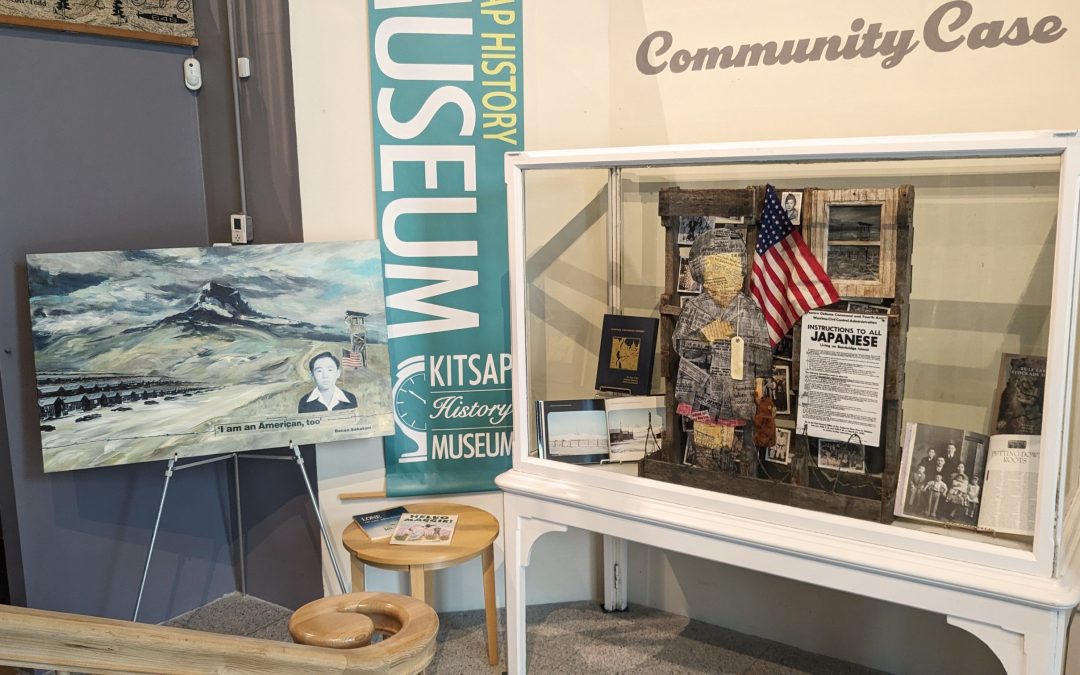This month’s Community Case is brought to you by local artist, Shirley Sakatani. Her sculpture, “The Ringle Report (hidden) : Unnecessary Imprisonment” recently won Honorable Mention at the 2024 Collective Visions Gallery Art Competition. Her piece educates the discrimination Japanese-Americans faced as a result of President Roosevelt’s Executive Order 9066. Bainbridge Island was targeted with Exclusion Order No. 1 on March 24, 1942.
Shirley Sakantani’s exhibit includes a collage painting titled “I Am American Too”, which shows her father, Bacon Sakani, as a child at the Heart Mountain Internment Camp and several personal texts on the topic.
Below excerpts are written by the artist, Shirley Sakatani:

“The Ringle Report (hidden) : Unnecessary Imprisonment” Mixed Media Sculpture by Shirley S Sakatani
3D Honorable Mentioned in the Collective Visions Gallery Art Competition 2024
Description: I portrayed a child who was part of the 120,000 Japanese Americans along the West Coast who were incarcerated during WWII in ten Internment Camps across the US in 1942-45. I show my father’s sister Yuri standing with authentic 1940’s teddy bear in hand, standing in front of her family bw photos (I used copies of our original family and friends photos) tacked behind her, within a barracks lined with tar paper (small cabins) the US military built for housing, barbed wire at her feet as the camps were surrounded (I got from WY) with a guard towers (shown in window), and vintage 1940’s American Flag with 48 stars, as the child pledges allegiance as a citizen of the United States. Upon her hand over her heart is written the Pledge of Allegiance, and her entire silhouette is covered with original newspaper articles from 1941-1942 on the round up and forced evacuation of all the Japanese. If you were a Caucasian married to a Japanese person you could choose to go to camp or stay and your spouse moved away. The Japanese were forced to sell, leave or destroy all of their belongings they had and could take “only what they could carry.” Some had to kill their own pets because there was nobody to care for them. They lost everything. On the backside, I show the “Ringle Report” of 1941 crumpled up and “hidden” under the palette boards, peeking through. This report was documentation showing that there was NO CAUSE for the incarceration of the Japanese community (due to the suspected of threat of invasion); yet, the report was HIDDEN/ignored by the govt. and discovered later in 1972. Hanging on the back is a poem my grandfather Frank Yamashita wrote 50 years after the camps and is translated in kanji. The gold origami atop symbolizes hope and peace.
It’s not an “artistic” piece but more about showing a story and educating about racism. My father Bacon Sakatani (and my mother Ailene) both had been in camp as children, but only later in life had become aware of this wrongdoing and has been educating the public about this terrible incarceration. Bacon was invited to the White House twice; for the signing of the Reparations Bill with Ronald Reagan and for the dedication of the National Japanese American Memorial, DC. I’m grateful to put this idea into a sculptural piece to see the many layers in the story that my parents and grandparents, great grandparents and the Japanese people went through due to their race. This is part of my family’s story I want to preserve.
“I Am an American, Too”, Mixed Media Painting by Shirley Sakatani
After being incarcerated with his family for three years at Heart Mountain Internment Camp in Wyoming for being of Japanese descent during WWII 1942-1945, my father, “Bacon” Sakatani, remembers returning to his high school in Southern California and being ignored and alone. In this piece I show the Heart Mountain Internment Camp, guard tower, barbed wire, mounds of coal to heat the barracks with a pot belly stove the families shared, with sheets hung as walls to separate rooms. My father recalls standing up in his high school after being released from prison camp and boldly stating, “I am an American, too.”
I’m very proud o my father’s years of involvement in preserving the memories of the 120,000 Japanese and Japanese Americans who went peacefully to the internment camps, and for the many who fought and were killed serving in the US military while their own families were imprisoned. Bacon has been invited to the White House twice and participated in the National Japanese American Memorial dedication in Washington, DC.
Link to a video in 1988 of my father Harumi “Bacon” Sakatani (b.1929) recalling his time in high school.

